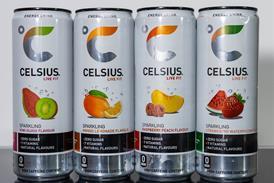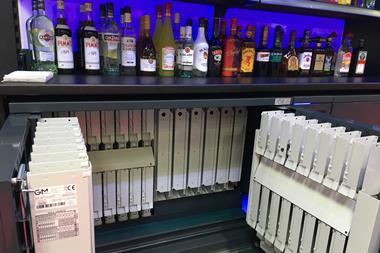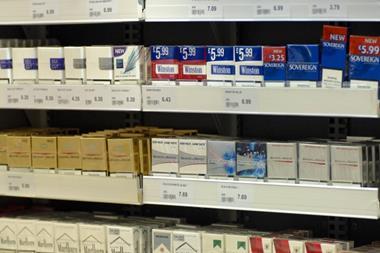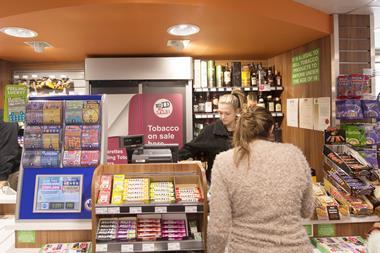With shutters down on the traditional gantry and many retailers opting for alternative display solutions, C-Store asks is there still a need for tobacco to retain its prime back-wall positioning?
Tobacco: it might be under fire, but with a current UK market value of £15bn this footfall-driving category remains a key contributor to convenience store sales. For many stores, in fact, it’s still the number one. However, with tobacco now screened off from view and a payload of new legislation, including plain packaging and new European Tobacco Products Directive (EUTPD) rules set to hit the industry from 20 May, is there really a need for it to retain its prime back-wall position?
It’s a question being posed increasingly frequently by forward-thinking independent retailers - and for many of those no longer tied to manufacturer contracts, the answer is a resounding “no”.
They aren’t alone as large national players such as BP/M&S have opted to replace their tobacco gantries with slick-looking OTC medicine merchandising solutions, storing tobacco in low-level draws instead.
The move certainly seems understandable, especially when you consider just how noticeable this prime back-wall space is to shoppers.
New data from HIM Research & Consulting reveals that while two-thirds of convenience shoppers are non-smokers, more than 60% of them have noticed that gantries are now covered up. The stats demonstrate that “there is a real opportunity to use this space to advertise products and promotions and display products”, HIM says.
And a growing number of retailers are doing just that, moving tobacco to less prominent positions in a bid to make space for higher margin goods such as premium spirits, electronic cigarettes (e-cigs), printer cartridges and medicines.
Take Jai Singh, owner of Go Local Extra in Sheffield . He’s replaced his old tobacco gantry with an overhead solution from Italian company Expotutto and now uses the key back-wall space to merchandise high-end spirits, retro sweets and a much bigger range of e-cigs.
“Our premium spirit sales are doing really well since we made the change, and we now regularly sell £25 bottles, which we never did before. Retro sweets are also doing well, which is great as they make us a margin of 85%. We also have a whole bay of e-cigs which bring people in from quite a distance. It’s made us much more of a destination shop,” he says.
“There is a school of thought that the traditional-style back-wall gantries with doors do still offer a small marketing opportunity as adult smokers can get a glimpse of your range when you slide the doors open to retrieve a product. However, I don’t think that’s an important factor in our store. Our tobacco customers enter the store with a fixed idea of the tobacco brand they want, or they just ask us for whatever’s cheapest. They aren’t interested in browsing the range. As a result, tobacco’s position in the store is becoming less and less important.
“All that matters is that we sell it and have good availability of the brands our shoppers want.”
Ramesh Shingadia also opted to remove his old back-wall gantry when he refitted his Londis Caterways store in Horsham, West Sussex, late last year. Tobacco is now stored in seven drawers under the counter, with the top four dedicated to the fastest-selling lines and lower drawers used for slower sellers and 10s. His tobacco sales are actually up 10% year on year following the refit, which has seen total sales grow by 40%.
Tobacco has been replaced by high-end spirits on the back wall, and more space is also being devoted to seasonal displays which create in-store theatre. “At Christmas we used it to promote special offers on Prosecco and Champagne, which had a real impact,” says Ramesh. “However, losing the gantry wasn’t a decision we took lightly. Gantries on the back wall do help to signpost the fact that you sell tobacco, which is still a key category.
“We ensured that we communicated the change thoroughly to our local customers and we made sure that lots of age-restricted sales posters were displayed prominently around the store to highlight that tobacco was still being sold. We also have the price list on display. The fact that tobacco sales are up is proof that the message has been understood.”
He says there are other advantages to moving tobacco. “The drawers will allow us to take a much more flexible approach to ranging when the EUTPD changes start to take effect and small packs run out, and they have reduced our stockholding as we don’t have to keep a large gantry looking full.”
Ramesh also points out that the move has increased the store’s security as would-be criminals can no longer see where the store stocks tobacco “and they don’t know what we are selling”.
There’s also the advantage of not being tied to a long five- or seven-year contract in a challenging market, he adds.
For others, the loss of the back-wall gantry has opened up an opportunity to create a unique look. David Worsfold, owner of the innovative Farrant’s in Cobham, Surrey, decided to move all his fast-selling tobacco lines to under-the-counter drawers as part of a significant store refurbishment project. “As long as you have good staff training and stock management systems in place, in my opinion there is absolutely no need for a back-wall gantry any more. Keeping tobacco in drawers under the counter has had absolutely no impact on our sales or customer service, and it has allowed us to create a striking bespoke look for our store with attractive wooden panelling and a large backlit image of a Cuban tobacco farm gracing the wall instead.”
Premium cigar and pipe tobacco brands are housed in a separate ‘tobacco room’ to the rear of the store which can only be accessed by over-18s.
However, David does have some words of warning. “What has become clear is that when you remove the gantry there remains a need for a visual cue or signage on the back wall that states that you sell tobacco. We have a large sign that says ‘We Sell Tobacco’, but it’s amazing how many people still ask us if we sell it!” he adds.
Independent retailer Chaz Chahal, who is just about to open a new Simply Fresh store in Inkberrow, Worcestershire, has also opted to keep his tobacco in drawers under the counter. The move will enable him to create a bespoke back-wall display for premium spirits, with a similar look to Roli Ranger’s Londis store in Sunninghill, Berkshire.
“I’d been going backwards and forwards about what kind of display solution to install at Inkberrow and finally settled on two bays of sliding doors under the counter,” says Chaz. “My solution is nice and simple, and I think that’s the key. Tobacco will be stored in trays with spring-loaded inserts which will make it easy for staff to see the brands on display and what needs replenishing.
“I’m planning on displaying premium spirits on the back wall in the place where tobacco would once have been. They’ll be merchandised in rustic-looking wooden crates so should look really good. I’ll keep that section under constant review, though, to see if there are any other opportunities to explore, such as e-cigarettes perhaps.”
Going automatic
A great many other retailers, such as Neil Jones from Spar Hazel Grove in Stockport, have chosen to replace their traditional gantries with automated dispensers from Navarra Retail Systems. These can be located in backroom areas, or behind the counter where they can be fitted with high-impact media screens or shelving for other product categories.
Navarra head of new business Hugh Walker says: “As our dispensers have slat wall shelving, we recommend this is used to further increase behind-the-till space by placing the pharmacy and small electrical brands on the dispenser doors.
“These small and light items don’t require full-depth shelving and thus free up this space for other items such as spirits, which provide more margin and need to be safe behind the till.
“The newly freed-up space provides opportunities for brand partnerships. We are about to announce a partnership with a large e-cig company which will provide retailers with significant benefits in terms of space utility and improved margins. It will utilise the space on the front of our dispensers for their product merchandising combined with promotional media screens. The screens will also be able to show other local events and in-store promotions,” he adds.
For Neil, another advantage of the automated system is the beefed-up security provided by the automated dispenser’s super-strong steel doors. “Our store had encountered a growing number of evening hold-ups and night-time break-ins before the unit was installed. The unit has worked well and stopped the crime,” he says.
A similar story was told to C-Store by another successful independent retailer, whose automated dispenser system thwarted a burglary earlier this year.
In this case, a night-time break-in was aborted when thieves, who cut through the roof to enter the store, were unable to break through the dispenser’s doors and fled empty-handed.
However, despite these positive retailer testimonials not all retailers plan to rip off the band aid just yet - particularly given that many thousands of convenience stores and newsagents are still tied to lengthy gantry agreements. Some retailers, such as Jatinder Sahota of Londis Sheppey, Kent, have even become quite fond of the traditional back-wall sliding door solution.
“My tobacco sales are actually up since the display ban came into force and my gantry supplier Imperial Tobacco has been very helpful,” he says. “Our local sales representative helped us create a planogram which really works. We delisted some slow sellers and introduced some new lines, and the results speak for themselves,” he says.
His comments will be well received by the UK’s key tobacco manufacturers, who remain adamant that the category is still deserving of its prime place on a c-store’s back wall.
JTI head of communications Jeremy Blackburn says: “With pending legislative changes such as EUTPD we would advise retailers to think very carefully about experimenting with new ways of managing the tobacco category. Tobacco is the number one contributor to store turnover and with a tobacco shopper having the potential to be worth £2,000 a year, retailers cannot afford to lose their footfall and the associated purchases they bring. At a time of such significant changes on the horizon it is not a good time to confuse your tobacco shoppers even further by moving the selling point for tobacco.”
An Imperial Tobacco spokesman also urges caution about undergoing major changes. “Gantries are a mainstay of the back-wall space around the world, regardless of whether the market is restricted by legislation or not.
“In Australia speed of service and availability in a plain pack environment evidenced that back-wall units provided the best solution, and the traditional gantries remained consistent throughout.”
In Seaford, East Sussex, Bipin Haria of Seaford News also reports a positive experience when working with Imperial Tobacco on his back-wall sliding solution, which he plans to keep - for now. “That may change in 2017/18 once plain packaging and all the EUTPD laws are fully in force,” he warns.
“By then I may consider moving to an overhead solution which would free up vital back-wall space for higher-margin categories such as spirits. To be honest, I am already questioning tobacco’s place behind the counter now that it is no longer visible. If people want to buy tobacco and they know we sell it, they will. I think it will matter less and less where it’s positioned,” he says.
Just how many other retailers are planning similar courses of action once gantry contracts expire remains to be seen, but we expect it to become a growing trend. We guess it’s a matter of ‘watch this space’.
Alternatives
Automated tobacco dispenser

Automated tobacco dispensers are fast becoming the solution of choice for many retailers, and more than 2,000 have now been fitted across the UK and Ireland.
Easily positioned in back office areas or behind the counter and covered up with media screens or promotional displays, the dispensers link to stores’ existing epos systems. They allow staff to serve customers at the press of a button, with packs taking just one second to be dispensed from drawers built into the unit.
A 1.5 metre automated gantry costs about £5,000, but there are lease finance options available for about £25 a week, according to Navarra head of new business Hugh Walker.
The dispensers also offer a natural ‘first in, first out’ stock rotation and added security against staff theft and robberies. “When one large petrol forecourt operator installed our dispensers they said their tobacco profitability went up immediately as all shrinkage stopped,” Walker adds.
Alternatives
Under-the-counter drawers

One of the cheapest solutions to implement, under-the-counter drawers are growing in popularity. Staff do not need to turn their backs to serve customers, and they can easily spot and retrieve brands once the drawers are open if they are clearly segmented with dividers and ranged alphabetically.
Drawers are Surrey retailer David Worsfold’s tobacco storage of choice at his Farrant’s store in Cobham. “The only slight problem with the drawers can be access,” he says. “They’re under the counter so sometimes staff serving at the till points can be in each other’s way when the drawers need to be opened. Other than that it’s all very easy and we’ve invested in high-quality solid drawers so wear and tear hopefully shouldn’t be an issue.”
Alternatives
Overhead system

Hundreds of stores are now thought to have been fitted with the Servertab overhead dispensing systems from Expotutto, with many reporting highly positive benefits.
Jai Singh of MJ’s Go Local Extra in Sheffield is one: “We are fortunate to have quite high ceilings and we installed the unit in a recess, which means it’s hardly visible from the customer side of the counter. It’s great as it’s basically making money out of what was effectively dead space before. It’s also enabled us to focus on other categories such as e-cigarettes, retro sweets and premium spirits, which are now on the back wall where the old gantry used to be.
“There are so many benefits to the overhead unit from a service point of view. Staff can easily see all the lines we stock and what needs replenishing without having to open and close doors or draws. Also, it means that staff don’t need to turn their backs to locate products,” Jai adds.
Members of the NFRN, Best-one, Booker and Today’s Group all qualify for a discount.































1 Readers' comment